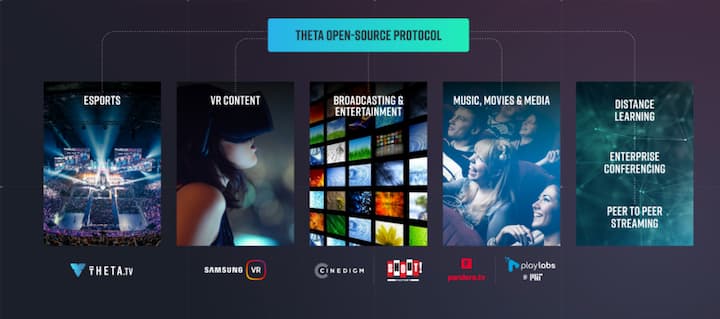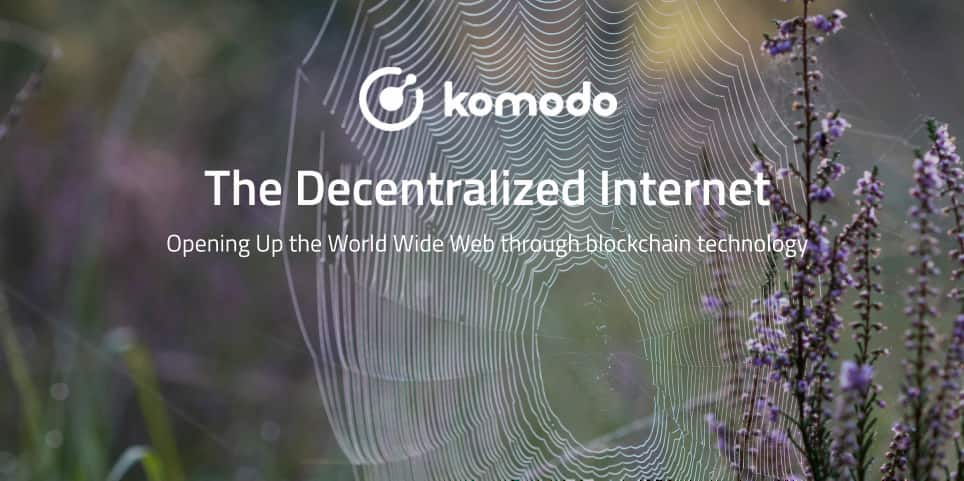The decentralized internet is a concept revolving around the use of distributed web technologies, protocols, and applications to make the internet fundamentally more open and accessible.
The decentralized internet directly contrasts with the centralized internet - the de facto internet of today that is mainly controlled by a few large tech companies. These tech giants wield an enormous amount of power, acting as gatekeepers by determining and enforcing policies for their users.
In this article, we’ll examine how the decentralized internet is challenging the status quo of the centralized internet. We’ll look at peer-to-peer protocols and applications that are playing an integral role in the growth of the decentralized internet. Finally, we consider the feasibility of decentralizing the existing web.
History of The Internet: A Brief Summary
Although the internet only gained widespread popularity just prior to the start of the 21st century, its fast evolution shows just how quickly technology is changing. Along with tech improvements, the user experience is changing each day. Generally, most experts would agree that we can break down the early history of the internet into three main eras: Web 1.0, Web 2.0, and Web 3.0.
Web 1.0: Early Days of The Internet
In August 1991, the internet first became publicly available. This kicked off the era of Web 1.0, which was comprised almost exclusively of static websites. Few interactive websites, such as forums or social media platforms, existed. This first generation of web technologies was centered around presenting information to end-users and acting as a globalized telephone directory.
Another important trait of Web 1.0 was that is was predominantly peer-to-peer. Individuals on the internet would create and post content directly to other users, whether on a unique website or on a message board or forum. It was not necessary to register or sign up for an account with a centralized platform in order to participate; users simply posted what they wanted, when they wanted.
This was essentially the “wild west” of the internet. There were few rules or policies for end-users. Although advanced decentralized technologies did not exist, no companies or websites truly dominated the landscape. As a result, Web 1.0 was vastly more decentralized compared to the internet of 2019.
Web 2.0: Current De Facto Internet
The term Web 1.0 did not exist until Darci DiNucci coined the term “Web 2.0” in 1999. It is commonly accepted that Web 2.0 started around 2004.
During this era, the internet became increasingly interactive in large part due to the rise of social media. These platforms produced no content of their own and instead relied exclusively on user-generated content. While Web 1.0 also relied on user-generated content, even if much of it was in the form of rudimentary websites, Web 2.0 made it much easier for users to post everything from text and photos to videos and music. Facebook, Twitter, YouTube, and other platforms all became integral parts of the web and remain so today.
The biggest drawback is this phenomenon led to the centralization of the internet. Essentially, a few companies have become dominant and now exercise a great deal of control over the user experience. In other words, Web 2.0 evolved into a series of "gated garden" communities where users had to sign up or register with a centralized platform in order to participate and interact with other users. As a result, something as simple as a user interface redesign or complex as censorship policies can be implemented by the platform itself, without input from end-users.
In addition to peer interaction on the internet, Web 2.0 infrastructure is also controlled by a few giant tech corporations. As of Q3 2019, Amazon Web Services and Microsoft Azure control 58 percent of the public cloud infrastructure market. This means developers have few options for launching websites or applications, which not only leads to increased costs but also greater potential for security risks.
Moreover, it raises serious concerns about the conflicts of interest that may arise with so much power concentrated in the hands of so few corporations. For example, Amazon Web Services (AWS) controls about 39 percent of the cloud computing market and powers a number of major websites, including several direct competitors. Netflix is powered by AWS but, as Amazon enters the streaming market with Amazon Prime, AWS has incentive to throttle Netflix bandwidth to gain a competitive edge.
For end-users, internet service providers (ISPs) in many regions of the world may also have monopolies that determine if and how people access the internet. Many of these companies have a poor track record and have notoriously used their power to charge exorbitant fees, monitor and censor user activity, sell user data, and take other actions that violate netizen rights.
Web 3.0: The Decentralized Internet
The term Web 3.0 was coined by John Markoff of the New York Times in 2006. The exact start date for Web 3.0 is unclear, as there are a number of technologies that are part of the so-called “intelligent Web.” The reality is that Web 3.0 is not really here yet because most of these technologies and applications are still in development. Natural language search, data mining, machine learning, and artificial intelligence technologies are all innovations from this era that are still in progress.
The definition of Web 3.0 can expand further to include the emergence of open technologies, open identity, and distributed computing. The adoption of these technologies is already beginning, but Web 2.0 still dominates by comparison.
The main thrust of Web 3.0 is to decentralize the internet, putting power and control of the internet back into the hands of its users, rather than in the hands of a few massive corporations. The goal is to democratize the internet, allowing people to self-govern the digital space known as the Web.
User experiences are changing as a result of this push for decentralization. Web 3.0 is promoting a transition towards user-run applications that reduce or eliminate the need for intermediaries or owners. Some people regard the start of Web 3.0 to be when the the Bitcoin network introduced Proof of Work as the first blockchain to implement decentralized consensus in 2009. Others might consider the starting point to be the initial release of IPFS in 2015 or the emergence of decentralized applications (dApps) in 2016 and 2017.

What is Decentralized Internet?
The decentralized internet meaning is difficult to precisely define, but it can generally be defined as a web infrastructure that is powered by any number of peer-to-peer (P2P) technologies. Here are three relevant examples of decentralized internet technologies being used today.
InterPlanetary File System (IPFS)
InterPlanetary File System (IPFS) is a peer-to-peer hypermedia protocol designed to make the web faster, safer, and more open. This protocol solves many of the challenges that have faced HyperText Transfer Protocol (HTTP) since it was introduced in 1991.
IPFS works by assigning a file, and all of the blocks within it, a unique fingerprint called a cryptographic hash. It removes duplicates across the web, and network nodes store content. InterPlanetary Name System (IPNS) ensures that every file with a unique cryptographic hash can be found by human-readable names, similar to how files can be named locally on a computer.
According to the US Library of Congress, the average lifespan of a webpage is only 100 days. IPFS allows webpages to be stored and found permanently. It does this by content-addressing, which decouples content from hosting servers.
IPFS also saves up to 60% bandwidth for video, offering potential improvements for sites like YouTube. This protocol uses content-signing to protect against DDoS attacks, which have been a common threat in Web 2.0. IPFS is currently used for numerous applications: P2P messaging, e-commerce, identity authentication, file sharing, and cloud storage, among others.
Dat
Dat is a protocol for sharing data between computers and enabling non-technical users to publish online. Dat is similar to IPFS for a few reasons. Both are functional in Web browsers as well as CLIs. They also perform similar functions like decoupling content from origin servers via content-addressing and enabling searches for peers that contain specific pieces of data.
However, there are a number of differences that distinguish the two protocols. Dat’s original use case revolved around the storage and distribution of scientific data. More applications for Dat are possible but still largely experimental. Developers are using the protocol for websites, art, music releases, and peer-to-peer network chat programs.
Secure Scuttlebutt (SSB)
Secure Scuttlebutt (SSB) is a database protocol for unforgeable append-only message feeds. This means that digital signing enables the owner of a feed to make updates. It works by forming a global cryptographic social network with its peers. Each user is identified by a public key and publishes a log of signed messages, which other users follow socially.
SSB is primarily used for peer-to-peer applications and encrypting messages but is also being applied as a decentralized technology for Git collaboration, chess games, and online gatherings. Developers can build on top of SSB by creating or using plug-ins for specialized APIs or database queries.
Decentralized Internet & Decentralized Applications (dApps)
It can be difficult to determine what makes an application decentralized or centralized. A number of factors go into determining this, and the definition of the word “decentralization” itself is often a matter of debate. What one person considers to be decentralized might be centralized to another. With that being said, some have attempted to answer this question.
Three areas to consider are architectural (de)centralization, political (de)centralization, and logical (de)centralization. Essentially, any application can fall somewhere in a sliding scale between 100% centralized or 100% decentralized. Let’s look at how dApps are challenging the status quo of the centralized web in different verticals.
One example is Komodo Wallet — Komodo's P2P atomic swap decentralized exchange. There are dozens of other dApp categories, so let's look at a few examples.
Social Media dApps
Most social media dApps share a few common characteristics. They often use cryptocurrencies as an incentive model for user participation.
Centralized social media platforms (i.e. Facebook, Instagram, Twitter, etc.) feature targeted ad networks that rely upon the collection of user data to sell ad space to third-party businesses. In contrast, social media dApps enable users to control their own data. Ad networks on decentralized platforms usually incentivize active viewers and/or provide an option for opting-out of ads.
Examples
- Atlas is a location-based experience recommendation app that rewards content creators who provide information about hotels, restaurants, bars, clubs, shops, museums, and other travel and lifestyle venues.
- Antube is a blockchain-based mobile video community app that rewards users who view mobile ads and videos.
- Steemit is a web-based blogging platform where users can earn rewards by posting articles and upvoting/downvoting content.
Decentralized Search Engines
Decentralized search engines have two main benefits. First, user data is not recorded for targeted ad campaigns as is common with centralized search engines, like Google and Bing. Second, these platforms maintain neutrality and do not manipulate search rankings based on paid campaigns, government legislation, corporate policies, human bias, or other factors. Combined with a decentralized internet browser like Brave Browser made by the Basic Attention Token, these search engines are good options for privacy preservation.
Examples
- Desearch caters to searches related to cryptocurrency. It includes quick search buttons for Bitcoin, XRP, Ethereum, Bittrex, and Bitclave. Users can also perform general search queries related to non-crypto topics.
- Dsearch (not to be confused with the above-mentioned Desearch) is a search engine built by Presearch. The platform’s ad network enables users to receive rewards by performing searches.
- Nebulas is working on the development of a search engine for decentralized applications based on the Nebulas value ranking; however, it has yet to launch.
Decentralized Exchanges (DEXs)
A decentralized exchange (DEX) is a platform which allows two individuals to directly trade cryptocurrencies without the need for a third-party intermediary. Transactions on DEXs take place on a single blockchain or across different blockchains, as with atomic swaps.
This type of exchange eliminates the required trust of using a centralized exchange (CEXs) to keep funds secure. While CEXs have a bad track record of security breaches and stolen funds, DEXs are considered more secure due to their non-custodial architecture.
Examples
- IDEX, KyberSwap, and 0x Protocol are a few examples of top DEXs by trading volume. However, many of today’s top DEXs are limited to trading on a single blockchain. For these examples, only Ethereum (ETH) and ERC tokens are exchangeable.
- Komodo Wallet utilizes atomic trading technology, meaning that assets can be swapped across the Ethereum blockchain and various UXTO-based blockchains (Bitcoin, DASH, Zcash, Komodo, and more).
Can The Web Of Today Become A Decentralized Internet?
Although a number of decentralized applications are being developed as part of the transition to Web 3.0, this is not the only way in which this new era might gain user adoption. Established websites, particularly those in social media, are considering the implementation of decentralized policies and technologies due to issues inherent with centralized platforms.
Problems With Popular Social Media Sites
In early 2018, the Cambridge Analytica scandal rocked Facebook. It was revealed that the firm harvested the personal data of 87 million Facebook profiles (70.6 million from US users) without consent. Data included each user’s public profile, page likes, birthday, and current city. Some users gave permission for the app to access their News Feed, timeline, and messages.
Cambridge Analytica created psychographic profiles of and suggested political advertisements to users based on their physical location and political preferences. This data leak most likely influenced the outcome of the 2016 US Presidential Election. The Cambridge Analytica scandal is an inherent problem with all centralized social media platforms, which collect user data for the express purpose of selling it to whomever is willing to pay. As a result, there are fears that similar incidents will continue to influence future elections around the globe.
For many years, YouTube has been criticized for its algorithm bias. In 2019, both right-wing and left-wing groups filed separate lawsuits against Google, YouTube’s parent company.
PragerU, an unaccredited non-profit university, alleged that videos were “unlawfully censored.” At the same time, LBGTQ+ creators alleged that the platform denied “freedom of expression.” Although YouTube did not remove any videos from either group, it did label them as “restricted.” As a result, around 1.5 percent of users were unable to see this content. This amounts to an estimated 28.5 million users.

Twitter’s Guidelines On Decentralization
In December 2019, Twitter CEO Jack Dorsey announced that the company would launch Blue Sky, a small independent team of up to five open source architects, engineers, and designers who will work on creating a decentralized standard for the internet.
The goal is to ultimately convert Twitter from a centralized platform into a decentralized protocol. The motivation behind this is to remove the task and burden of content moderation. Decentralizing the website potentially means the company will no longer bear legal responsibility for the platform’s content.
Feasibility of Decentralizing Large Websites
Twitter’s decision to explore decentralization could create a new model for other Web 2.0 companies to follow. However, this might also turn out to be merely an experiment. Several potential issues can arise when companies decentralize.
First and foremost, there are still technical challenges, especially related to scalability. Current limitations also affect the up-and-coming decentralized platforms mentioned above but are even more apparent when trying to implement on websites and applications that already have millions or billions of users.
Additionally, users will likely have to adjust to major changes in how the platform functions. It is possible that users will be willing to stay on the platform as decentralization takes place. Still, there are significant risks like a drop in active users, and thus revenue, for the company.
The two major advantages that large Web 2.0 companies typically have are engineering resources (i.e. developers, designers, researchers, etc.) and capital. Although it is certainly possible that decentralization could fail, the chances of success are likely much higher than for smaller startups.
Centralized platforms also dominate when it comes to the number of users. While some decentralized platforms now have over one million active users, a centralized platform like Facebook has 1.88 billion daily active users.
Komodo’s Role In Building The Decentralized Internet
Komodo is a platform focused on providing tools for decentralized internet blockchain technologies. And, as mentioned above, Komodo Wallet is one prominent example of a decentralized application.
The Komodo Dev Team is also working to build the infrastructure necessary for applications to run more efficiently on the decentralized internet. Komodo Lead Developer jl777 has created a superlight client called nSPV (Simple Payment Verification), which enables blockchain transactions to verify much quicker while continuing to maintain a high level of security.
This technology was first introduced in August 2019 and solves many of the limitations of existing solutions (i.e. Electrum SPV). The Komodo team is continuing to develop nSPV and exploring how it can be integrated into existing decentralized applications. Web browser extensions, IoT devices, and blockchain gaming applications are just a few use cases in which this technology could be applied to advance the adoption of Web 3.0.
📧Komodo Newsletter
If you'd like to learn more about blockchain technology and keep up with Komodo's progress, subscribe to our newsletter. Begin your blockchain journey with Komodo today.

